I putting what I quote from the Web in italics.
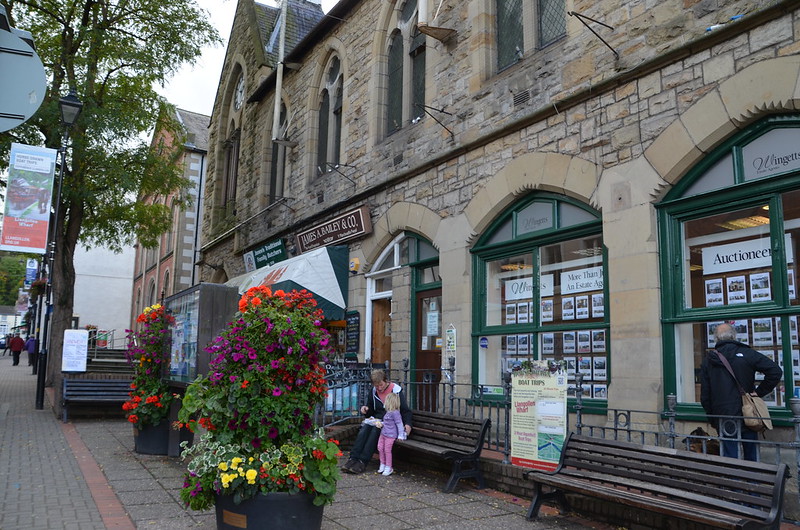
Llangollen is a small town and community in Denbighshire, north-east Wales, situated on the River Dee and on the edge of the Berwyn mountains. It has a population of 3,412. It's difficult for me to pass by flowers and not take a photo. I noticed these outside James A. Bailey & Co. on Castle Street. I lucked out here, capturing as well a cute little girl with her dad, I'll bet. I wonder if they got the food he has in his lap at Bailey's. I read this online about The Food Emporium: If you're planning a picnic or lunch on the run, drop in here for filled baguettes and paninis, gourmet sausage rolls, homemade pies (try a Welsh Oggie – a meat, potato and onion pasty), Welsh ales and ice cream. I wonder about that building--it looks like a church to me.
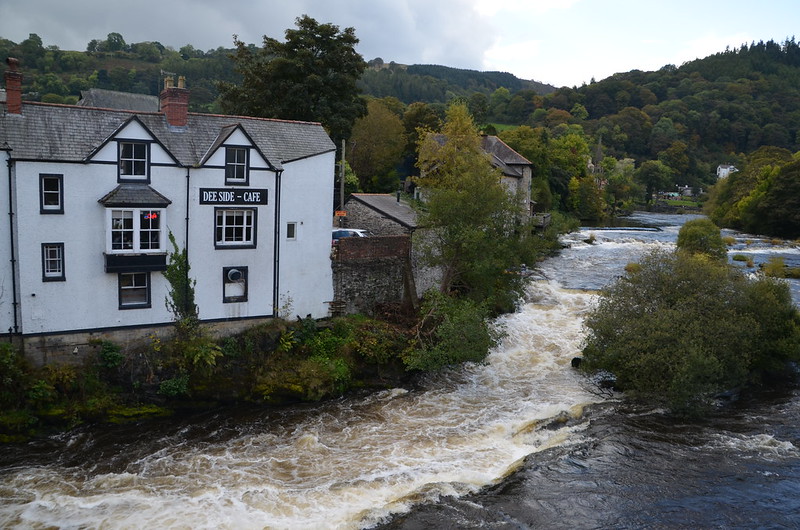
Llangollen takes its name from the Welsh llan meaning "a religious settlement" and Saint Collen, a 6th-century monk who founded a church beside the river. St Collen is said to have arrived in Llangollen by coracle. As there are no other churches in Wales dedicated to St Collen, it is possible that he may have had connections in Colan in Cornwall, and Langolen in Brittany. I read this online about the Dee-Side: The Dee Side Bistro is located on the banks of the River Dee in the beautiful Welsh retreat of Llangollen. You can sit and enjoy our exquisite food or drinks with picturesque views, of the the River Dee and surrounding stunning scenery. Hmmm. I wonder if you can hear the river from inside the cafe. I took this photo from the bridge over the River Dee.
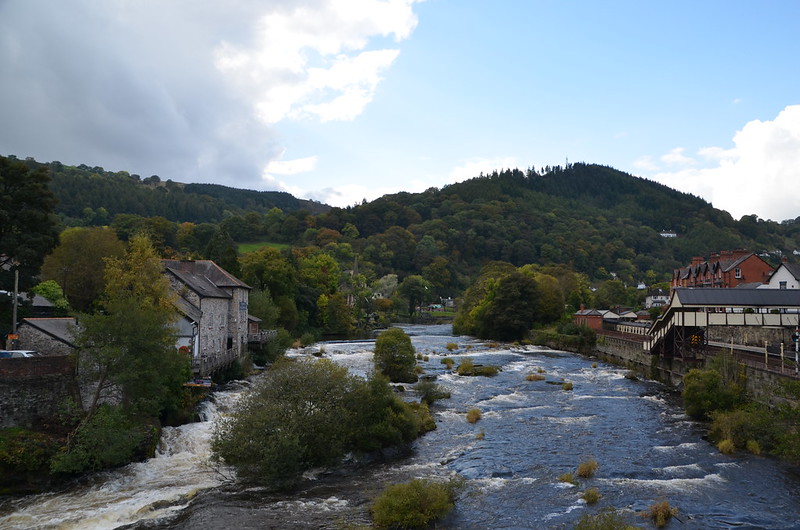
Inside this a great wide shot! Llangollen Bridge: There are references to a bridge at Llangollen as far back as 1284 but the first stone bridge was built by John Trevor, the Bishop of St Asaph in 1345.
Rebuilding took place in 1656, and a stone with this date and the name of the stone mason, Rondle Reade, was found during a later bridge widening. The downstream side of the bridge is unaltered since the 15th century but the bridge has been widened twice on the upstream side.
In 1871 a census recorded 6585 people, 298 horses, 129 waggons, 92 carts and 79 cattle using this 8 foot wide bridge – sufficient evidence of chaos to justify the 1873 widening! In 1863 the symmetry of the arches had been spoilt by the addition of the railway arch and, during this work, pieces of tombstones with Latin inscriptions were found, thought to have come from Valle Crucis Abbey. The widening in 1968 was due to traffic congestion.
Llangollen’s bridge is regarded as one of the ‘Seven Wonders of Wales’: “Pistyll Rhyadr and Wrexham Steeple, Snowdon’s Mountain without its people, Overton yew trees, St Winefride’s Wells, Llangollen Bridge and Gresford bells.”
My main goal after eating lunch was to walk all the way across the bridge and then get back to the coach on time. Oh, and to allow enough time to stop by the Buttered Crust for one last visit to the facilities--we'd gotten approval for that from the folks who worked when we paid our lunch tab. Later on I discovered that the gray buildings on the riverbank beyond those trees were the village's mill. More about that later in today's post. Gosh, I wish we'd had hours to spend in Llangollen!
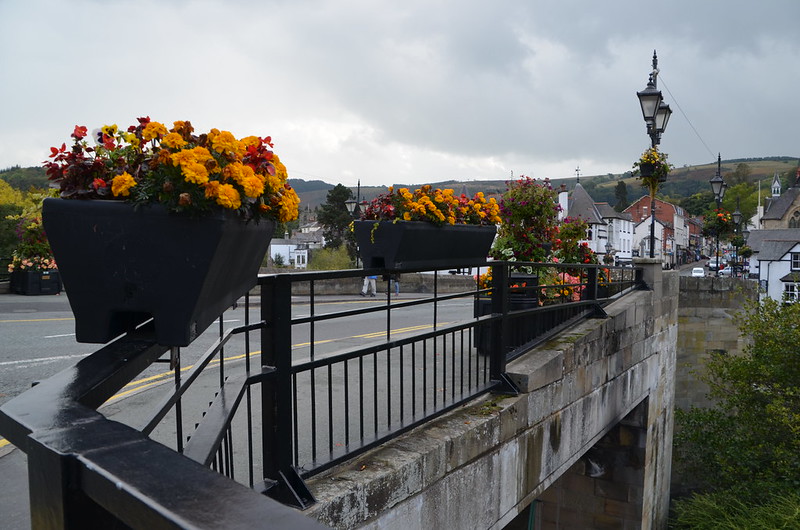
Today Llangollen relies heavily on the tourist industry, but still gains substantial income from farming. Most of the farms in the hills around the town were sheep farms, and weaving was an important cottage industry in the area for centuries. Several factories were later built along the banks of the River Dee, where both wool and cotton were processed. I made it to the other side of the bridge and turned back to take this photo. Love these flowers all along the bridge.
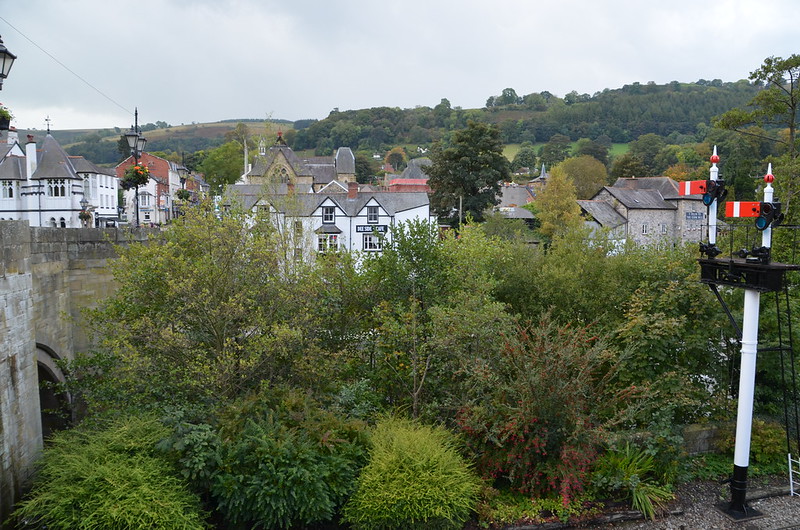
You can see the Dee Side Cafe through the tops of the trees that line the river bank. In between me and the trees are the railroad tracks. Notice the gray stone buildings to the right of the photo? There's a rectangular sign on the rightmost one. It says The Corn Mill. I looked it up online--it's another restaurant.
From The Corn Mill's Web site: The Corn Mill has been grinding flour for at least seven hundred years, and owes its foundation to the Cistercian monks of Valle Crucis. It is first mentioned in a 13th Century document dealing with a fishing dispute between the freemen of Llangollen and the Abbot.
The building as it now stands was re-built in 1786 with three pairs of grinding stones, and continued as a working mill up until 1974. By the time Jerry and Graham came across it, however, it was sadly derelict and in danger of falling into the river. It is owned by a friend of Jerry’s called Phil Brown, and we ended up leasing the mill from him for fifty years. We used a very talented chap called Owain Evans as architect, and appointed Read and Co., a decent local builder with a good reputation. Planning permission took years, because of course it’s an important old building.
The planning authorities, based in Ruthin, thought the conversion to a pub/restaurant was a great idea and wanted it to go ahead. The conservation officer really wanted the building restored to a mill. The local council didn’t want the thing at all, and in addition we had to deal with the Historic Mills people, the River Authority and CADW, (the Welsh building conservation body), each of whom had a different agenda, so at times it was like herding cats.
When we finally re-opened the building in June 2000, lots of people came to see what we had done with it, as there is genuine affection for the Mill locally. There was a lot of excitement when we finally got the water wheel turning again for the first time in twenty-five years.
One visitor, who has since become a regular, had been born in a bedroom upstairs, and found on our walls a framed photograph from the 1950’s of her father with his dog in a coracle on the Mill race. We still have the actual coracle, which we’ve mounted on the wall at the top of the stairs. She insisted that in the ceiling of the ground floor there had been a huge ship’s beam with a 17th century date carved into it, but we’ve never found it.
The place has gone like a train from the very beginning. Mind you, if we’d known how much it was going to cost from the outset, the truth is we probably would never have started.
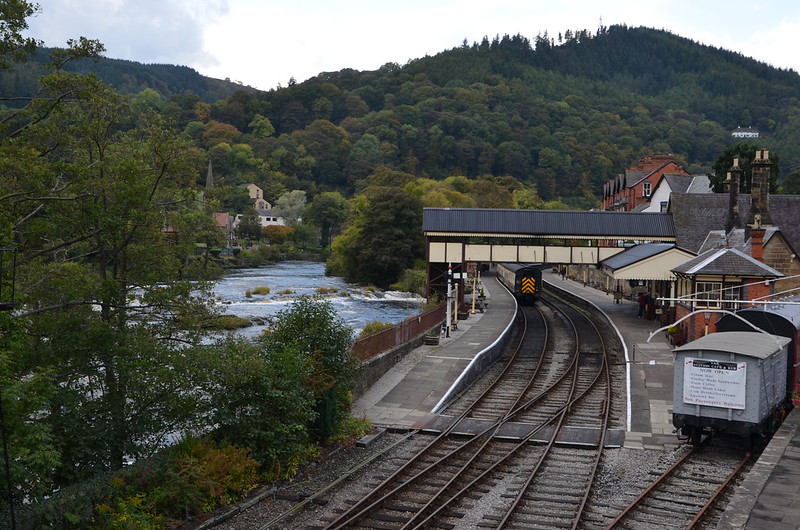
The railroad tracks and the train station. The railway was extended from Ruabon, via Acrefair and Trevor, to reach Llangollen by 1865, operating passenger and goods services. Thie Ruabon to Barmouth Line became part of the Great Western Railway. One hundred years later the line closed under the Beeching Axe of 1964, closing to passengers in early 1965, and to freight in April 1969. The line was lifted in May 1969. However, a 10-mile stretch of the line has been restored between Llangollen and Corwen and operates as the Llangollen Railway, a tourist attraction. In 2002, the Rainhill locomotive trials were re-staged on the line. I also read this online: 1n 1953 The Queen and Prince Philip arrived in Llangollen by train as part of a tour of Wales. There are still people in Llangollen who remember travelling from Llangollen to London without changing! The line and station closed in 1965 and for years it was left in a terrible state, falling to ruins and full of weeds. The station and the line as far as Carrog, to the west were re-opened by volunteers in the 1970s and continues to operate as a major tourist attraction.

Looking at my watch, I realized I needed to start back, so I walked along the street to the end of the bridge. Then I decided to take a photo of this appropriately named hotel. I found this on the Llangollen Museum's Web site: The early history of the Bridge End Hotel is difficult to determine exactly. Early 18th century paintings of Llangollen appear to show no buildings at the northern end of the bridge. A map from 1791 does show a building but this may be the Bishop Trefor next door.
The Bridge End Hotel first appears in records in the 1840s, both in Pigot’s business directory and on the tithe map. At this time the inn was owned by John Jones of Rhysgog and run by Robert Wright. He was succeeded by Richard and Mary Parry who were in turn followed by Eliza Whittaker in the 1880s, paying an annual rent of £37 to Martha Baker. At this time both sides of the inn were two storey buildings, with the upstairs on the right hand side reached by an external stairway.
At the end of the 19th century, however, the left hand part of the inn was raised to three stories and a new chimney installed in front wall of the right hand side. In 1927 the right hand half of the inn was also raised, the chimney first being taken down and rebuilt onto the new taller building. Eliza Whittaker was followed by Piercy J. Pace and A.W. Crowhill before S.R. Johnson moved from the Royal Hotel to manage the inn in the 1930s.

2 comments:
It all looks so perfect.
The old stone in some of these buildings reminds me of the odd small town here as well. I love the look of that river.
Post a Comment